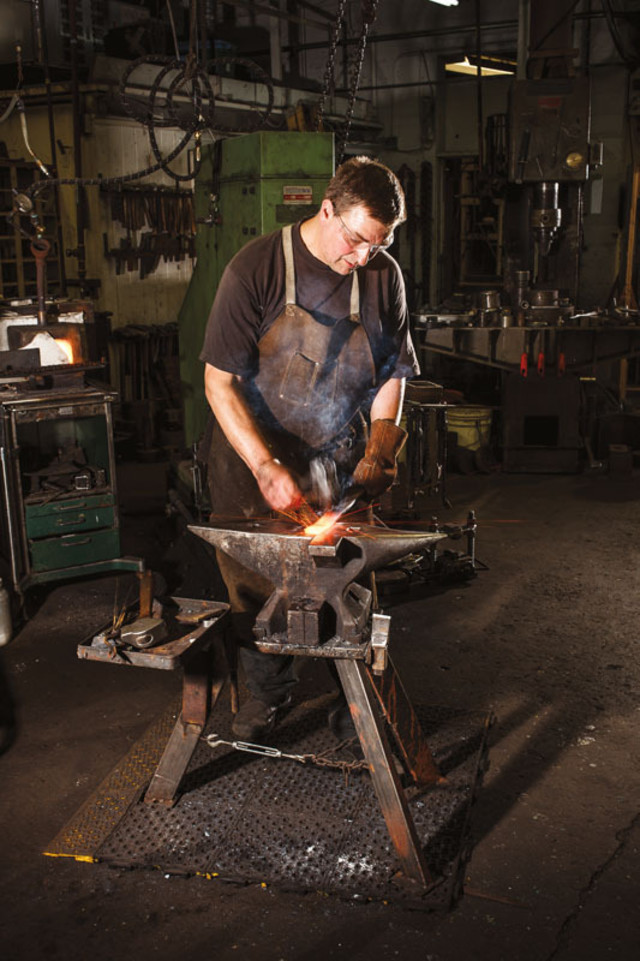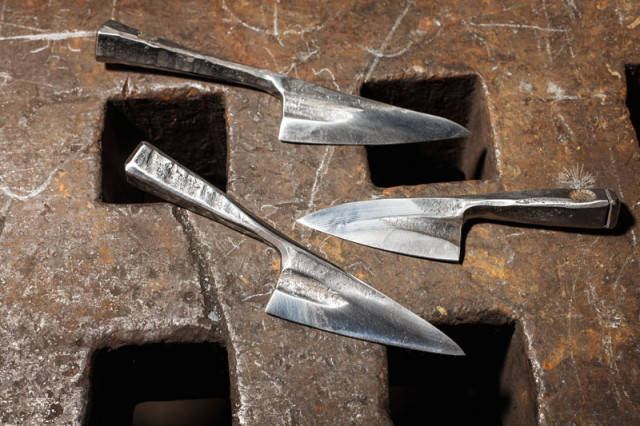Portland's Globetrotting Blacksmith

Image: Stuart Mullenberg
In the middle of boring midnight guard duty at an army mechanics shop, an 18-year-old Israeli soldier picked up a two-inch-thick hacksaw blade. He salvaged a handle from a gurney, and made unauthorized use of the shop’s blade grinder.
“I was the envy of the unit,” Arnon Kartmazov says 30 years later, as he reclines in his own workshop in North Portland. “You’re in the field, you need to cut a loaf of bread or a rope. A big chunk of hacksaw—thick, long, heavy—made an excellent knife. I carried it for years until someone nicked it.”
Today, the blacksmith creates tools and art far more refined, but equally fierce: razor-sharp custom kitchen knives, massive door hinges and handles that could support the oaken portal of a king’s keep, and sculptures that include a T. rex stalking a West Linn park. His shop, Bridgetown Forge, is a gearhead wonderland, where presses with cogs three feet across stand near at least a dozen anvils, forges, and metal ingots.
His most formidable creation, however, may be his own biography.
Born in a small Soviet mountain town in 1963, Kartmazov moved to Israel at the age of 11, when the USSR loosened its emigration rules. (“I don’t know why Israel, because we also had family in the US,” he says now. “But it was better than the Soviet Union.”) After his late-night epiphany, Kartmazov apprenticed with Israeli blacksmiths before setting off for Japan. In that land of aesthetic obsession—where a wooden sauna bucket embodies generations of design—his interest cured into a calling. “I wasn’t thinking of blacksmithing as a career,” he says now. “But there’s a Russian saying: the beast will find the hunter.”

Of an early apprenticeship, Kartmazov recalls: “You stand in this hole. You cannot escape.”
Image: Stuart Mullenberg
A veteran local swordmaker took him on as an assistant. Kartmazov toiled in a shop that abutted fields of rice and sugarcane, where he would stand in a traditional coal-fired pit forge for hours. On one of his first days, dehydrated and overheated, he emerged to take in the view.
“The sun was crawling toward the ocean,” he recalls. “We sat there drinking tea. I looked at the sweat drying on me and I decided, this is what I will do. This has meaning.”
He moved to Portland in 2000 because he and his wife, an American, wanted change. (She also wanted to study acupuncture in the US.) “We were looking for a place to belong,” Kartmazov says. “Portland was real. It wasn’t one of those horrid strip malls to the horizon.” That choice fits a larger philosophy evident in every gleaming blade that takes shape beneath his hammer: form must follow function.
“It’s the reason you stop and stare at a galloping horse,” Kartmazov says. “Why is a galloping horse beautiful? Because it is completely functional. That is why.”



